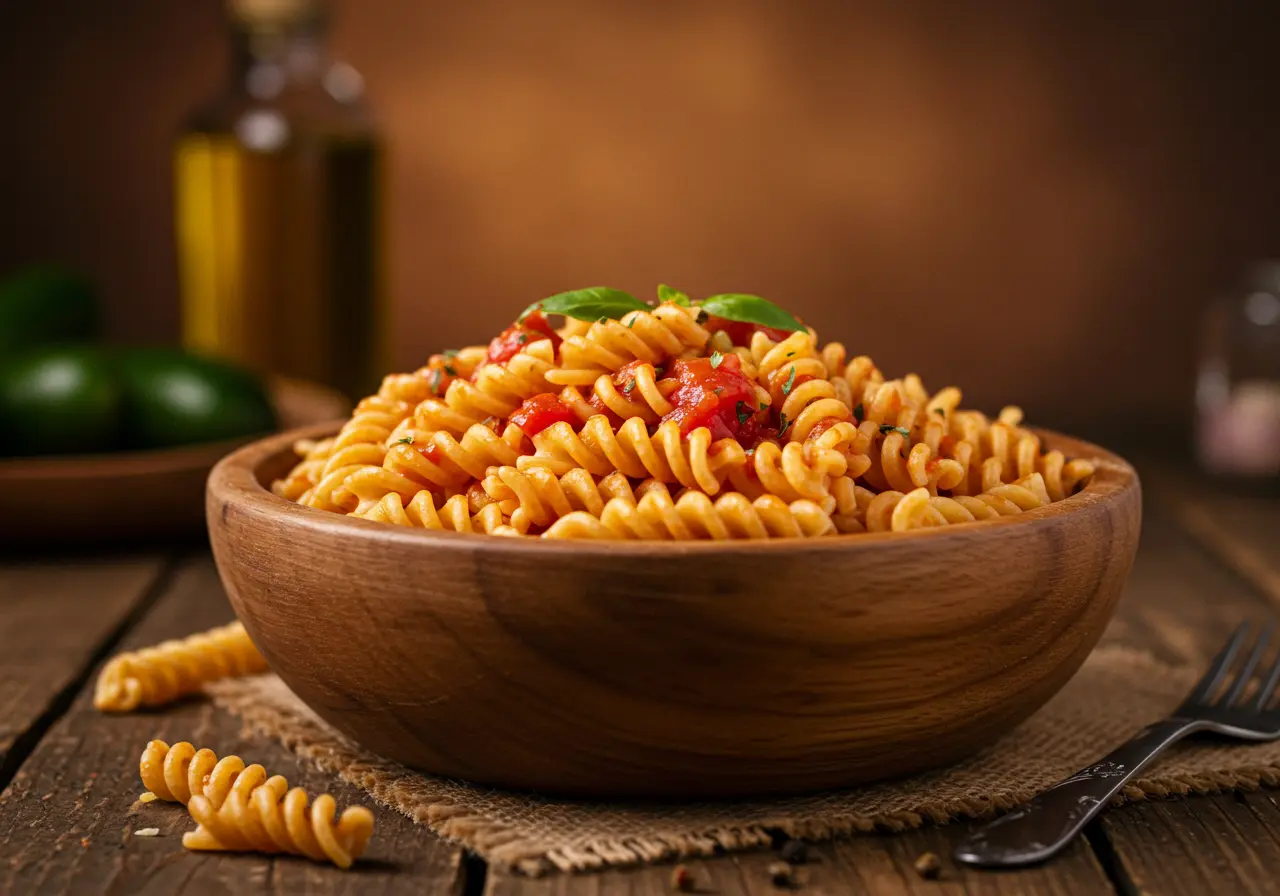Introduction
Pasta lovers, gather around! If you enjoy a hearty, satisfying bowl of pasta, chances are you’ve come across the corkscrew pasta. This spiral-shaped delight isn’t just visually appealing—it’s also perfect for clinging to rich sauces, making it a favorite in various dishes. From cavatappi to fusilli and rotini, different corkscrew pasta types have distinct textures and culinary uses.
But have you ever wondered about the history of these pasta shapes? Or why they work so well in certain recipes? In this guide, we’ll take you through everything you need to know—from the origins of corkscrew pasta to the best sauces and cooking techniques. Let’s dive into the fascinating world of spiral pasta!
Part 1: Understanding Corkscrew Pasta
What is Corkscrew Pasta?
Corkscrew pasta refers to a group of pasta shapes with a spiral or helical structure. Their unique design helps them hold onto sauces better than smoother pasta varieties. Whether tossed in a rich tomato sauce or a creamy cheese blend, these spirals are designed to lock in flavor.
Popular Varieties of Corkscrew Pasta
While several pasta types fit the corkscrew category, the most common include:
- Cavatappi – A ridged, tubular pasta with a slight twist, perfect for mac and cheese.
- Fusilli – A short, twisted pasta, excellent for salads and baked dishes.
- Rotini – Similar to fusilli but with tighter spirals, great for thicker sauces.
Each of these pastas has a slightly different texture and function in cooking, which we’ll explore further.
The History of Corkscrew Pasta
The origins of corkscrew pasta trace back to Italy, where pasta-making has been a tradition for centuries. Twisted pasta shapes emerged as pasta makers experimented with different ways to capture and hold sauces.
By the late 19th century, industrial pasta production allowed for more variety, and spiral shapes like fusilli and rotini became household staples. Over time, cavatappi gained popularity, especially in America, where it became a go-to pasta for mac and cheese.
Why is Corkscrew Pasta So Popular?
The love for spiral pasta isn’t just about aesthetics—it’s about practicality! Here’s why it’s a kitchen essential:
Better Sauce Absorption – The grooves and twists hold onto sauce, ensuring each bite is flavorful.
Versatile in Dishes – Works well in baked recipes, cold salads, and hearty meals.
Great for Texture – Its firm bite makes it a favorite for those who love al dente pasta.
Because of these advantages, corkscrew pasta remains a beloved staple in cuisines worldwide.
Part 2: Varieties of Corkscrew Pasta
Not all corkscrew pasta is the same! While they all share a twisted, helical shape, each variety has distinct characteristics that make it ideal for different dishes. Let’s take a closer look at the three most popular types of corkscrew pasta: cavatappi, fusilli, and rotini.
Cavatappi: The Curly, Tube-Shaped Delight
Cavatappi, meaning “corkscrews” in Italian, is a short, tube-shaped pasta with a tight spiral and ridges. Unlike traditional tubular pasta like penne, cavatappi has a double-helix twist, making it a standout choice for dishes that need extra sauce retention.
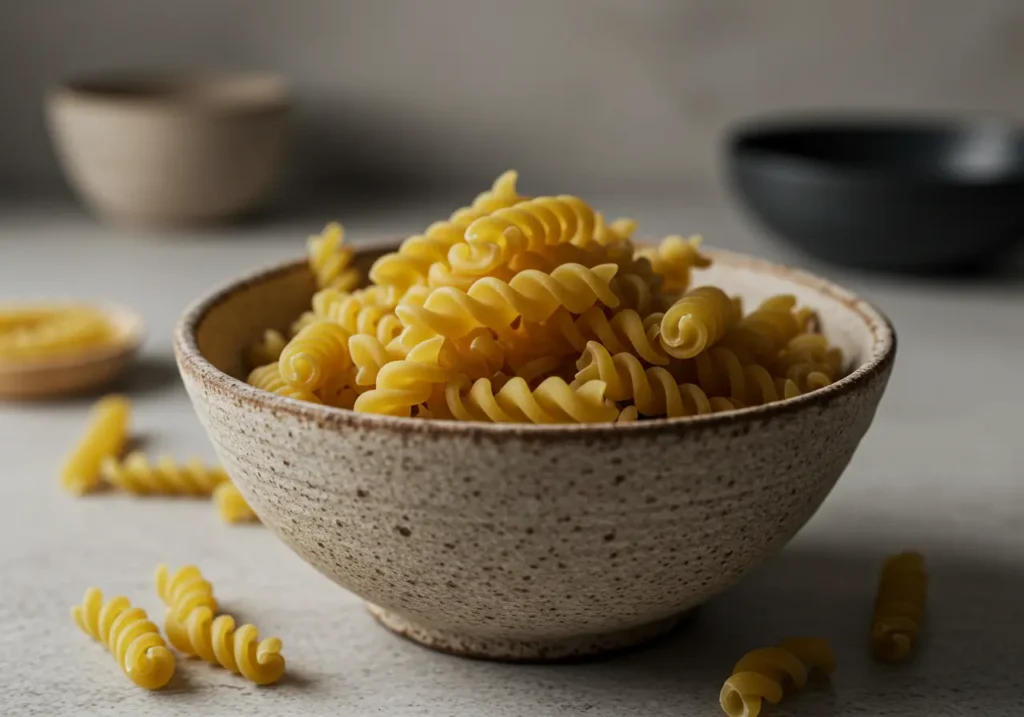
What Makes Cavatappi Unique?
- Ridged Surface – Holds onto creamy or chunky sauces exceptionally well.
- Hollow Center – Allows sauces to seep inside, making every bite flavorful.
- Firm & Springy Texture – Provides a delightful chewiness, even after cooking.
Best Uses for Cavatappi
Cavatappi is a versatile pasta that works well in:
- Mac and Cheese – Its shape traps cheese sauce beautifully, making it an upgrade from traditional elbow macaroni.
- Baked Pasta Dishes – Works wonderfully in casseroles and baked pasta with marinara or béchamel.
- Pasta Salads – Holds up well in cold pasta salads with vinaigrettes or creamy dressings.
Cooking Tip:
To get the perfect al dente texture, boil cavatappi for about 8-10 minutes in well-salted water. Overcooking can make it too soft and less chewy.
Fusilli: The Classic Spiral Pasta
Fusilli, another widely loved corkscrew pasta, consists of tight, spiral-shaped twists that resemble a coiled spring. Originally hand-rolled around thin rods, fusilli’s short, sturdy shape makes it ideal for both hot and cold dishes.
Why Fusilli Stands Out
- Tightly Wound Spirals – Allows it to hold both thick and light sauces.
- Compact Yet Robust – Doesn’t break easily, even in heavily mixed dishes.
- Easy to Cook – Cooks evenly, making it great for quick meals.
Popular Fusilli Dishes
- Pasta with Pesto – The grooves grab onto pesto sauce, ensuring every bite is flavorful.
- Tomato-Based Pasta – Works well with chunky marinara or Bolognese.
- Cold Pasta Salads – Retains texture even when mixed with veggies, cheese, and dressing.
Fusilli vs. Rotini: Are They the Same?
While fusilli and rotini look similar, fusilli has a tighter, more defined spiral, whereas rotini has a looser, corkscrew-like twist. Fusilli often feels softer and smoother, while rotini offers more resistance to the bite.
Pro Tip:
Boil fusilli for 10-12 minutes to keep it firm yet tender. Pair it with oil-based sauces for a lighter dish or cream-based sauces for a richer experience.
Rotini: The Versatile Corkscrew Pasta
Rotini, meaning “small wheels” in Italian, is a short, tightly wound corkscrew pasta similar to fusilli. However, it has a slightly looser twist, making it ideal for thicker, chunkier sauces.
Why Choose Rotini?
- Thicker Build – Stands up to heartier ingredients like ground meat, beans, and vegetables.
- More Surface Area – Allows it to cling to thicker sauces better than traditional spaghetti or penne.
- Great for Hearty Meals – Works exceptionally well in casseroles, stews, and baked pasta.
Rotini in the Kitchen
- Classic Meat Sauce Pasta – Pairs well with hearty tomato sauces, absorbing flavors deeply.
- Cheesy Bakes & Casseroles – Perfect for baked pasta dishes where cheese melts between the spirals.
- Vegetable-Packed Pasta – Holds up well in stir-fried or sautéed veggie pasta dishes.
Cooking Tip:
For perfect rotini, boil for 7-9 minutes to maintain a firm texture. If using it in baked dishes, slightly undercook it to prevent mushiness.
Which Corkscrew Pasta is Right for You?
| Pasta Type | Shape & Texture | Best Uses |
|---|---|---|
| Cavatappi | Hollow, ridged spirals | Mac and cheese, baked dishes, creamy sauces |
| Fusilli | Tightly wound spiral | Pesto, tomato-based sauces, pasta salads |
| Rotini | Looser corkscrew shape | Thick meat sauces, cheesy bakes, veggie pasta |
Each variety of corkscrew pasta has its own strengths, but they all share one thing: their amazing ability to hold sauces and make every dish unforgettable.
Part 3: Culinary Applications of Corkscrew Pasta
Corkscrew pasta isn’t just about looks—it’s about functionality in the kitchen. With its twisted, spiral design, it excels at holding sauces and blending seamlessly into a variety of dishes. Whether you’re whipping up a creamy mac and cheese or tossing together a refreshing pasta salad, corkscrew pasta brings a chewy, satisfying bite that makes every meal special.
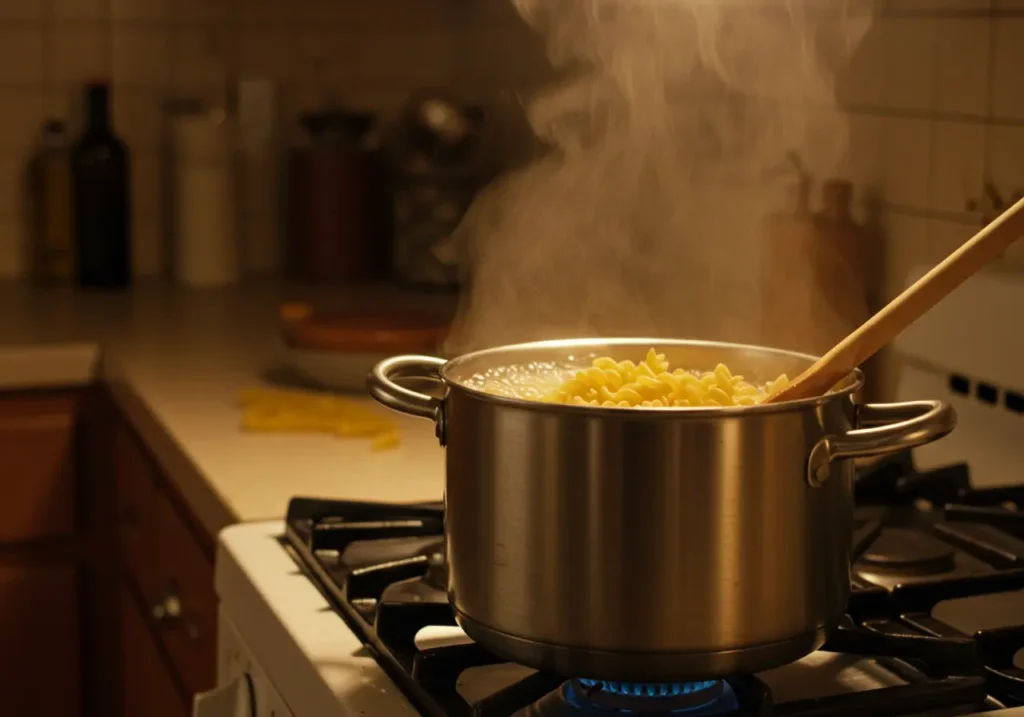
Perfect Sauce Pairings for Corkscrew Pasta
Not all pasta shapes pair well with every sauce. The twisted structure of corkscrew pasta makes it perfect for capturing thick, textured sauces while still holding up in lighter preparations. Here’s a breakdown of ideal sauce pairings:
Cream-Based Sauces – Best for Cavatappi
- Alfredo Sauce – The velvety, creamy consistency clings to the ridges of cavatappi.
- Cheese Sauce – Perfect for mac and cheese; its hollowness locks in gooey goodness.
- Béchamel – A light white sauce that enhances baked dishes.
Tomato-Based Sauces – Best for Fusilli & Rotini
- Marinara – A simple tomato sauce that spirals can grip onto beautifully.
- Bolognese – Thick and meaty, rotini holds up well to the richness of this sauce.
- Arrabbiata – The nooks and crannies of fusilli trap the spicy heat of this sauce.
Oil & Herb-Based Sauces – Best for Fusilli
- Pesto – The tight twists catch every bit of basil, garlic, and Parmesan.
- Garlic & Olive Oil (Aglio e Olio) – A light, refreshing coating for pasta salads.
- Lemon Butter Sauce – A delicate pairing that enhances seafood pasta dishes.
These pairings elevate the texture and taste of corkscrew pasta, ensuring every bite is flavorful and balanced.
Popular Corkscrew Pasta Recipes You’ll Love
Now that we know what sauces work best, let’s dive into some of the best dishes you can make with corkscrew pasta. These recipes showcase its versatility in creamy, baked, and chilled dishes.
1. Ultimate Cavatappi Mac and Cheese
Ingredients:
- 12 oz cavatappi pasta
- 2 cups shredded sharp cheddar
- 1 cup mozzarella
- 1 cup milk
- 2 tbsp butter
- 1 tbsp flour
- ½ tsp mustard powder
- Salt & pepper to taste
Instructions:
- Cook cavatappi until al dente.
- In a saucepan, melt butter, whisk in flour, then slowly add milk.
- Stir in cheese until melted and smooth.
- Combine with pasta, season, and serve hot!
✔ Tip: Add crispy breadcrumbs on top for extra texture!
2. Mediterranean Fusilli Pasta Salad
Ingredients:
- 10 oz fusilli pasta
- 1 cup cherry tomatoes, halved
- ½ cup black olives
- ½ red onion, sliced
- ½ cup feta cheese, crumbled
- ¼ cup olive oil
- 2 tbsp balsamic vinegar
- Fresh basil
Instructions:
- Cook fusilli, then rinse with cold water.
- Toss with veggies, feta, olive oil, and balsamic vinegar.
- Garnish with fresh basil and serve chilled.
✔ Perfect for meal prep!
3. Cheesy Baked Rotini with Marinara
Ingredients:
- 12 oz rotini pasta
- 2 cups marinara sauce
- 1 cup shredded mozzarella
- ½ cup Parmesan
- ½ tsp Italian seasoning
Instructions:
- Cook rotini until slightly underdone.
- Mix with marinara sauce, layer in a baking dish, and top with cheese.
- Bake at 375°F (190°C) for 20 minutes until bubbly.
✔ Delicious comfort food that’s easy to make!
Nutritional Benefits of Corkscrew Pasta
Pasta is often misunderstood—some see it as “carb-heavy,” but in reality, corkscrew pasta provides essential nutrients when enjoyed in moderation.
1. A Good Source of Energy
Corkscrew pasta is rich in complex carbohydrates, which provide long-lasting energy. Unlike refined sugars, complex carbs release energy gradually, making pasta a great fuel source.
2. Enriched with Vitamins & Minerals
Many store-bought pasta varieties are enriched with B vitamins and iron, which support:
- Brain function (B1, B2, B3)
- Red blood cell production (Iron)
- Metabolism and energy conversion (Folate)
3. High in Fiber (When Whole Wheat!)
Choosing whole wheat corkscrew pasta provides more fiber, which:
- Improves digestion
- Keeps you full longer
- Helps regulate blood sugar levels
4. A Protein-Friendly Food
While not high in protein itself, corkscrew pasta pairs well with protein sources like:
- Chicken, shrimp, and tofu for a complete meal
- Legumes (lentils, beans) in pasta salads
- Cheese and eggs in baked dishes
Why Corkscrew Pasta is a Staple in Every Kitchen
With endless sauce pairings, easy-to-make recipes, and great nutritional value, corkscrew pasta is more than just a pantry staple—it’s a kitchen essential. Whether you crave a cheesy comfort dish, a light summer salad, or a hearty baked pasta, there’s a way to enjoy its unique texture and flavor-absorbing qualities.
Part 4: Cooking Techniques for Corkscrew Pasta
Mastering the art of cooking corkscrew pasta is crucial for achieving the perfect bite. While it may seem as simple as boiling water, the right technique ensures your pasta maintains its firmness, absorbs sauces efficiently, and doesn’t become mushy. Let’s break down the best cooking methods and common mistakes to avoid.
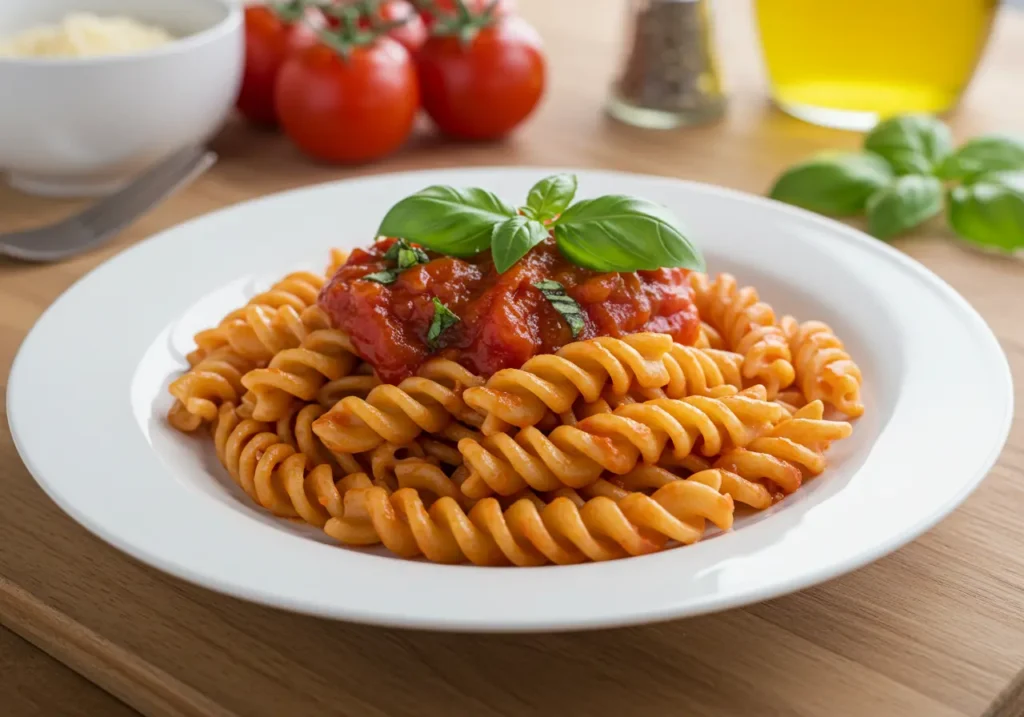
Proper Cooking Methods for Corkscrew Pasta
Cooking corkscrew pasta the right way ensures it maintains its twist, texture, and ability to hold onto sauces. Follow these steps for perfectly cooked pasta every time:
1. Use the Right Amount of Water
- Always use 4-6 quarts of water per pound of pasta. This prevents the pasta from sticking together.
- More water allows the pasta to move freely, ensuring even cooking.
2. Salt the Water Generously
- Add 1-2 tablespoons of salt per gallon of water before boiling.
- Salt enhances the pasta’s natural flavor, making it tastier even before adding sauce.
3. Bring Water to a Rolling Boil
- Never add pasta to cold or lukewarm water—wait until it’s at a full rolling boil.
- This prevents the pasta from becoming gummy or unevenly cooked.
4. Stir Immediately After Adding Pasta
- Stirring within the first 30 seconds ensures the pasta doesn’t stick.
- Keep stirring occasionally throughout cooking.
5. Cook Until Al Dente
- Al dente means “to the tooth”—pasta should be firm but not crunchy.
- Follow package instructions but start testing 2 minutes before the suggested time.
| Corkscrew Pasta Type | Cooking Time (Al Dente) |
|---|---|
| Cavatappi | 8-10 minutes |
| Fusilli | 10-12 minutes |
| Rotini | 7-9 minutes |
6. Reserve Pasta Water
- Before draining, save 1 cup of starchy pasta water.
- This can help sauces bind better to the pasta and create a smoother texture.
7. Drain and Toss Properly
- Avoid rinsing unless making pasta salad—rinsing removes starch that helps sauces stick.
- If using sauce immediately, toss pasta into the sauce while still warm.
Common Mistakes to Avoid When Cooking Corkscrew Pasta
Many home cooks make avoidable mistakes that can ruin the perfect bowl of corkscrew pasta. Here’s what not to do—and how to fix it!
Final Takeaway: The Secret to Perfect Corkscrew Pasta
Cooking corkscrew pasta is all about timing, technique, and avoiding common mistakes. By following proper boiling methods, using enough water and salt, and avoiding overcooking, you’ll ensure that your pasta is always firm, flavorful, and sauce-ready.
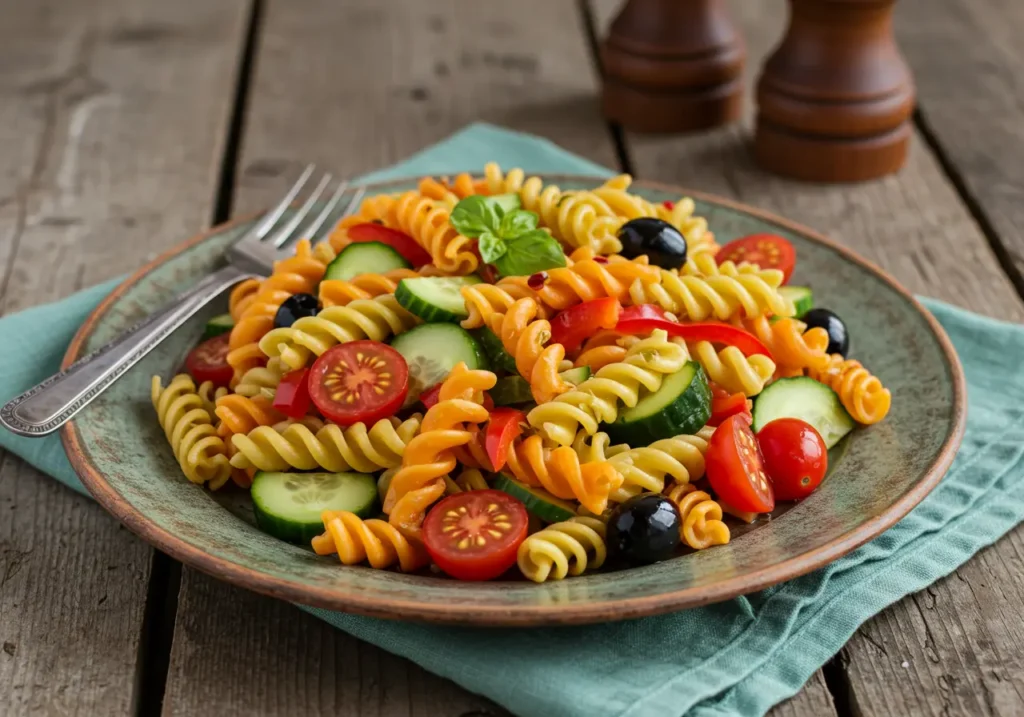
Part 5: Frequently Asked Questions (FAQs)
Many people are curious about corkscrew pasta, its different names, and how it compares to other pasta shapes. Here are some of the most commonly asked questions about this twisted, spiral pasta.
What is corkscrew pasta called?
Corkscrew pasta is a general term that refers to pasta shapes with a twisted, helical design. The most common types include cavatappi, fusilli, and rotini. These pasta shapes are known for their ability to hold onto sauces due to their grooves and curves. While some people use the terms interchangeably, each variety has a slightly different texture and thickness, which makes them ideal for different recipes. Whether used in creamy mac and cheese, zesty pasta salads, or hearty baked dishes, corkscrew pasta adds an interesting *twist—both in shape and flavor absorption—to any dish.
What is the name of the Italian twisted pasta?
The most well-known Italian twisted pasta is fusilli, which originates from Southern Italy. Historically, fusilli was handmade by rolling small pieces of pasta dough around a thin rod, thus creating its signature spiral shape. However, in modern times, it is mass-produced and widely available. As a result, it has become a staple in many dishes, including pasta salads, tomato-based recipes, and pesto pasta.Another Italian twisted pasta is cavatappi, which is a ridged, tube-shaped corkscrew pasta often used in cheesy and creamy dishes. These pastas are not just for aesthetics—their twisted shapes help sauces cling to them, making every bite packed with flavor.
What’s another name for spiral pasta?
Spiral pasta goes by many names, depending on the region and type of twist. The three most common names are:
- Fusilli – A tightly wound spiral pasta, often mistaken for rotini.
- Rotini – Similar to fusilli but has a looser, corkscrew-like twist.
- Cavatappi – A tube-shaped corkscrew pasta with a hollow center.
In some regions, fusilli is also called “spirali”, and in some American supermarkets, rotini and fusilli are used interchangeably. Regardless of the name, these pasta types excel at holding onto sauces, making them a favorite for both hot and cold dishes.
What are the noodles that look like corkscrews?
The noodles that resemble corkscrews are cavatappi, fusilli, and rotini. Each of these has a distinct shape and texture:
- Cavatappi – A ridged, hollow tube twisted into a corkscrew shape, perfect for creamy and cheesy dishes.
- Fusilli – A tightly coiled spiral pasta that pairs well with pesto, light sauces, and pasta salads.
- Rotini – A looser corkscrew pasta that works well with thicker, chunkier sauces like Bolognese.
These pasta varieties are great for absorbing flavors, enhancing textures, and adding visual appeal to your favorite pasta recipes. Their unique shapes help sauces cling better than smooth pasta, ensuring every bite is packed with flavor.
Print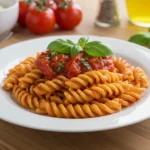
Corkscrew Pasta: Types, Cooking Methods, Best Sauces & Recipes
- Total Time: 25 minutes
- Yield: 6 people 1x
- Diet: Vegetarian
Description
Corkscrew pasta, including cavatappi, fusilli, and rotini, is perfect for holding onto sauces, making it a great choice for rich and flavorful dishes. This recipe features a creamy cheese sauce that coats every twist of the pasta, creating a comforting and satisfying meal.
Ingredients
Core Ingredients
- 12 oz corkscrew pasta (cavatappi, fusilli, or rotini)
- 2 tbsp unsalted butter
- 2 tbsp all-purpose flour
- 2 cups whole milk
- 1 cup shredded sharp cheddar cheese
- ½ cup shredded mozzarella cheese
- ½ tsp mustard powder
- Salt & black pepper, to taste
- ¼ tsp smoked paprika (optional)
- ¼ cup grated Parmesan cheese
- 1 tbsp olive oil (for boiling pasta)
Optional Toppings & Add-ins
- ½ cup cooked and crumbled bacon
- ¼ cup chopped fresh parsley
- ¼ tsp red pepper flakes for heat
Instructions
- Boil the Pasta: Bring a large pot of salted water to a rolling boil. Add the pasta and cook according to package instructions until al dente (firm to the bite). Drain and set aside.
- Prepare the Cheese Sauce: In a large saucepan, melt butter over medium heat. Stir in the flour and whisk continuously for 1 minute to create a roux.
- Add Milk & Thicken: Gradually add milk, whisking constantly to avoid lumps. Cook for 2-3 minutes until slightly thickened.
- Melt the Cheese: Reduce heat to low, then stir in cheddar, mozzarella, and Parmesan until melted and smooth. Add mustard powder, paprika, salt, and pepper to taste.
- Combine with Pasta: Add the drained pasta to the sauce and stir well to coat each piece evenly.
- Serve & Enjoy: Garnish with parsley, bacon, or red pepper flakes if desired. Serve warm!
Notes
For an extra creamy texture, stir in ¼ cup heavy cream before serving. If you prefer a baked version, transfer the pasta to a baking dish, top with breadcrumbs, and bake at 375°F (190°C) for 10 minutes.
- Prep Time: 10 minutes
- Cook Time: 15 minutes
- Category: Main Course
- Method: Stovetop
- Cuisine: Italian
Nutrition
- Serving Size: 1 bowl
- Calories: 450 kcal
- Sugar: 5g
- Sodium: 620mg
- Fat: 18g
- Saturated Fat: 10g
- Unsaturated Fat: 8g
- Trans Fat: 0g
- Carbohydrates: 52g
- Fiber: 3g
- Protein: 18g
- Cholesterol: 40mg
Keywords: Corkscrew pasta, creamy pasta, mac and cheese, fusilli recipe, cavatappi pasta

